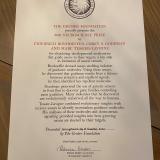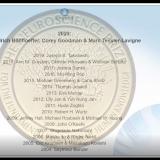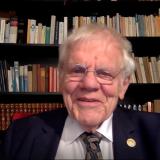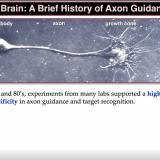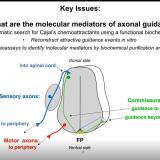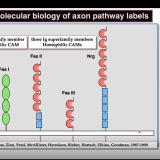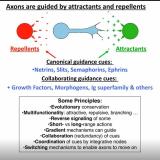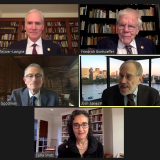2020 Gruber Neuroscience Prize
Friedrich Bonhoeffer, PhD, Corey Goodman, PhD, and Marc Tessier-Lavigne, PhD, have been pioneers in elucidating the molecular mechanisms that guide axons to their targets, a key step in the formation of neural circuits. Axon guidance was first described in the late 19th century, but the mechanisms that guide axons during brain development eluded scientists for decades. By the 1990s, axon growth was known to be guided by molecular cues, but their identity remained unknown. Bonhoeffer, Goodman, and Tessier-Lavigne were leaders in breaking through that scientific impasse. They co-discovered four major evolutionarily conserved guidance cue families – Netrins, Slits, Semaphorins and Ephrins – and many of their receptors, as well as numerous other important guidance mechanisms, transforming our understanding of how neural circuits are formed. They showed how contact attraction, chemoattraction, contact repulsion, and chemorepulsion act simultaneously and in a coordinated manner to direct axons along their paths and in forming topographic maps at their targets. Their groundbreaking findings have led to a deeper understanding of brain development and neural plasticity, with profound implications for neurodegenerative diseases such as dementia and for brain repair after injury.
2020 Neuroscience Prize Recipients
Laureate Profile
Friedrich Bonhoeffer, PhD, emeritus director of the Max Planck Institute for Developmental Biology in Tübingen, Germany, made pioneering contributions to understanding the molecular mechanisms behind axon guidance. In the 1970s and 1980s, he developed a series of innovative in vitro assays that enabled scientists to isolate the molecular cues that guide axons to their precise target in the target region. Using these assays, he made the surprising and transformative discovery that guidance is driven by repellent as well as attractive cues. He then went on to identify several of those signals. Among his seminal discoveries was the finding that the growth of one group of axons (temporal) in the chick retina is guided by the repellent cues of the anterior membranes of the tectum (the main visual center in the brain of chicks), which provided evidence that axons are guided to their targets by repulsive as well as attractive cues. This work led to the identification by Bonhoeffer and by others of the Ephrin guidance molecules, one of several major evolutionarily conserved guidance cue families. He went on to identify additional guidance mechanisms both through biochemical purification and by establishing the zebrafish as a model system for genetic analysis of guidance mechanisms.
Corey Goodman, PhD, a founding partner of venBio Partners in San Francisco, Calif., pioneered the use of genetic screens to identify the ligands, receptors, and their regulators that control axon guidance in insects. In his labs at Stanford University and later at the University of California, Berkeley, Goodman and his colleagues used those screens to isolate Semaphorins and Slits, two important evolutionarily conserved families of guidance molecules that guide axons during neural development, which were also independently identified in vertebrates. He also identified the Roundabout (Robo) family of Slit receptors, the Robo regulator Commissureless (Comm), and the Plexin family of Semaphorin receptors. Among his other seminal findings from these screens was the discovery of a molecular peripheral pathway label and its motor axon receptor, molecules that others subsequently showed defined gene families involved in axonal guidance along pathways toward their targets. Goodman’s work helped to establish that the molecules guiding axon development are highly conserved throughout the animal kingdom, a development that revolutionized the field.
Marc Tessier-Lavigne, PhD, president of Stanford University in Stanford, Calif., made groundbreaking contributions to understanding the molecular underpinnings of axon guidance. Working with the mammalian spinal cord, Tessier-Lavigne, identified multiple guidance systems and showed how they work together to effect accurate guidance. He biochemically purified Netrins and Slits, two major evolutionarily conserved families of guidance cues, which were also independently identified in invertebrate systems. He dissected the guidance of axons to and beyond the spinal cord midline, showing that axons are attracted to the midline by Netrins; that Netrins collaborate with a distinct midline attractant as well as a repellent that helps prevent the axons from straying from their path; and that leaving the midline involves the action of Slits and Semaphorins. Other major discoveries included the identification of vertebrate receptors for Netrins, Slits, Semaphorins and other cues, and of additional chemoattractants for diverse axonal populations. Tessier-Lavigne’s use of evolutionary insights combined with penetrating mechanistic and molecular analyses dramatically transformed scientific thinking about neural development.
Watch Video
Citation
The Gruber Foundation proudly presents the 2020 Neuroscience Prize to Friedrich Bonhoeffer, Corey Goodman and Marc Tessier-Lavigne for elucidating developmental mechanisms that guide axons to their targets, a key step in formation of neural circuits.
Bonhoeffer devised assays enabling isolation of guidance molecules. Using these assays, he discovered that guidance results from a balance between attractive and repellent signals; he then identified key repellent molecules.
Goodman pioneered the use of genetic screens in fruit flies to discover gene families controlling axon guidance. Many molecules that he discovered are evolutionarily conserved, all the way to humans.
Tessier-Lavigne combined evolutionary insights with incisive assays to identify mammalian guidance molecules. His analyses of these molecules and downstream signaling provided insights into how growing axons are steered to their targets.





